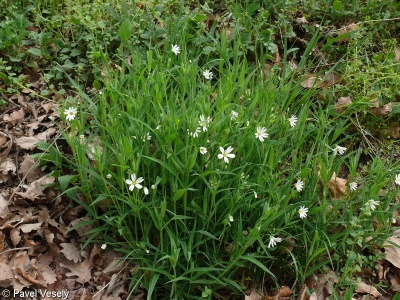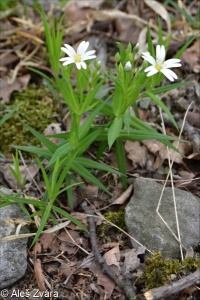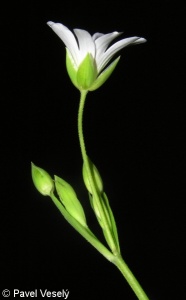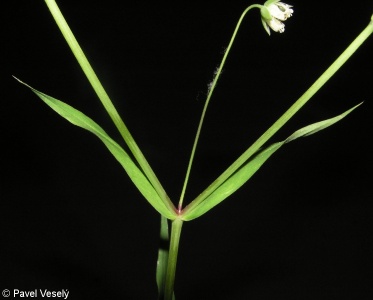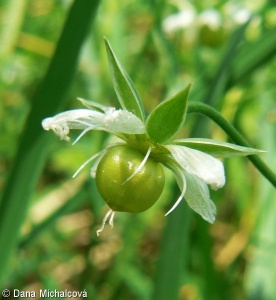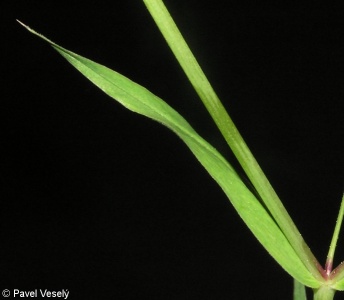Stellaria holostea
Data
download factsheetHabitus and growth type
-
Plant height [m]: 0.22?
Plant height
Data source and citation
-
Life span: Perennial?
Life span
Categories
- Annual
- Biennial or short-lived
- Perennial
Data source and citation
Dřevojan, P., Čeplová, N., Štěpánková, P., & Axmanová, I. (2023). Life span. – www.FloraVeg.EU.
-
Life form: Hemicryptophyte?
Life form
Categories
- Phanerophyte
- Chamaephyte
- Hemicryptophyte
- Geophyte
- Hydrophyte
- Therophyte
- Epiphyte
- Tree
- Shrub
- Woody liana
- Semi-shrub
- Dwarf shrub
- Herbaceous liana
Data source and citation
Dřevojan, P., Čeplová, N., Štěpánková, P., & Axmanová, I. (2023) Life form. – www.FloraVeg.EU.
Leaf
-
Specific leaf area [mm2/mg]: 27.86?
Specific leaf area
Data source and citation
Flower
-
Flowering period: March-June?
Flowering period
Data source and citation
Fruit, seed and dispersal
-
Seed mass [mg]: 2.83?
Seed mass
Data source and citation
-
Dispersal mode: Local non-specific dispersal?
Dispersal mode
Categories
- Local non-specific dispersal
- Myrmecochory
- Anemochory
- Dyszoochory
- Endozoochory
- Epizoochory
- Anthropochory
- Hydrochory
Data source and citation
Lososová Z., Axmanová I., Chytrý M., Midolo G., Abdulhak S., Karger D.N., Renaud J., Van Es J., Vittoz P. & Thuiller W. (2023). Seed dispersal distance classes and dispersal modes for the European flora. Global Ecology and Biogeography, 32(9), 1485–1494.
-
Dispersal distance class: 1?
Dispersal distance class
Data source and citation
Lososová Z., Axmanová I., Chytrý M., Midolo G., Abdulhak S., Karger D.N., Renaud J., Van Es J., Vittoz P. & Thuiller W. (2023). Seed dispersal distance classes and dispersal modes for the European flora. Global Ecology and Biogeography, 32(9), 1485–1494.
Trophic mode
-
Parasitism and mycoheterotrophy: autotroph?
Parasitism and mycoheterotrophy
Categories
- autotroph
- euphytoid hemiparasite
- obligate root parasite
- mistletoe
- parasitic vine
- endophytic parasite
- initial or partial mycoheterotroph
- full mycoheterotroph
Data source and citation
-
Carnivory: non-carnivorous?
Carnivory
Categories
- carnivorous
- non-carnivorous
Data source and citation
-
Symbiotic nitrogen fixation: no nitrogen-fixing symbionts?
Symbiotic nitrogen fixation
Categories
- symbiosis with rhizobia
- likely symbiosis with rhizobia
- unlikely symbiosis with rhizobia
- symbiosis with frankia
- symbiosis with cyanobacteria
- no nitrogen-fixing symbionts
Data source and citation
Taxon origin
-
Origin in Europe: native?
Origin in Europe
Categories
- native
- archeophyte
- neophyte
Data source and citation
Ecology
-
Environmental relationships
-
Substrate humidity relationship: Mesic?
Substrate humidity relationship
Categories
- Dry
- Mesic
- Wet
- Water
Data source and citation
-
Substrate reaction relationship: Slightly acidic to near-neutral?
Substrate reaction relationship
Categories
- Acidic
- Slightly acidic to near-neutral
- Alkaline
- Indifferent
Data source and citation
-
Nutrient relationship: Mesotrophic?
Nutrient relationship
Categories
- Dystrophic
- Oligotrophic
- Mesotrophic
- Eutrophic
- Hypertrophic
Data source and citation
-
Salinity relationship: Non-saline?
Salinity relationship
Categories
- Non-saline
- Slightly saline or brackish
- Saline
Data source and citation
-
Ellenberg-type indicator values
-
Moisture indicator value: 5.5?
Moisture indicator value
Data source and citation
-
Reaction indicator value: 5.7?
Reaction indicator value
Data source and citation
-
Nutrient indicator value: 4.9?
Nutrient indicator value
Data source and citation
-
Salinity indicator value: 0?
Salinity indicator value
Data source and citation
-
Disturbance indicator values
-
Disturbance frequency: 0.07?
Disturbance frequency
Data source and citation
-
Disturbance frequency (herb layer): 1.33?
Disturbance frequency (herb layer)
Data source and citation
-
Disturbance severity: 0.68?
Disturbance severity
Data source and citation
-
Disturbance severity (herb layer): 0.16?
Disturbance severity (herb layer)
Data source and citation
-
Mowing frequency: 0.03?
Mowing frequency
Data source and citation
-
Grazing pressure: 0.2?
Grazing pressure
Data source and citation
-
Soil disturbance: 0.11?
Soil disturbance
Data source and citation
Habitat and sociology
-
Syntaxon
-
?
Diagnostic species of phytosociological classes
Data source and citation
-
EUNIS habitat
-
?
Diagnostic species of EUNIS habitats
Categories
- MA211 Arctic coastal saltmarsh
- MA221 Atlantic saltmarsh driftline
- MA222 Atlantic upper saltmarsh
- MA223 Atlantic upper-mid saltmarsh and saline and brackish reed, rush and sedge bed
- MA224 Atlantic mid-low saltmarsh
- MA225 Atlantic pioneer saltmarsh
- MA232 Baltic coastal meadow
- MA241 Black Sea littoral saltmarsh
- MA251 Mediterranean upper saltmarsh
- MA252 Mediterranean upper-mid saltmarsh and saline and brackish reed, rush and sedge bed
- MA253 Mediterranean mid-low saltmarsh
- N11 Atlantic, Baltic and Arctic sand beach
- N12 Mediterranean and Black Sea sand beach
- N13 Atlantic and Baltic shifting coastal dune
- N14 Mediterranean, Macaronesian and Black Sea shifting coastal dune
- N15 Atlantic and Baltic coastal dune grassland (grey dune)
- N16 Mediterranean and Macaronesian coastal dune grassland (grey dune)
- N17 Black Sea coastal dune grassland (grey dune)
- N18 Atlantic and Baltic coastal Empetrum heath
- N19 Atlantic coastal Calluna and Ulex heath
- N1A Atlantic and Baltic coastal dune scrub
- N1B Mediterranean and Black Sea coastal dune scrub
- N1C Macaronesian coastal dune scrub
- N1D Atlantic and Baltic broad-leaved coastal dune forest
- N1E Black Sea broad-leaved coastal dune forest
- N1F Baltic coniferous coastal dune forest
- N1G Mediterranean coniferous coastal dune forest
- N1H Atlantic and Baltic moist and wet dune slack
- N1J Mediterranean and Black Sea moist and wet dune slack
- N21 Atlantic, Baltic and Arctic coastal shingle beach
- N22 Mediterranean and Black Sea coastal shingle beach
- N31 Atlantic and Baltic rocky sea cliff and shore
- N32 Mediterranean and Black Sea rocky sea cliff and shore
- N33 Macaronesian rocky sea cliff and shore
- N34 Atlantic and Baltic soft sea cliff
- N35 Mediterranean and Black Sea soft sea cliff
- Pa Base-poor spring and spring brook
- Pb Calcareous spring and spring brook
- Pc Brackish-water vegetation
- Pd Fresh-water small pleustophyte vegetation
- Pe Fresh-water large pleustophyte vegetation
- Pf Fresh-water submerged vegetation
- Pg Fresh-water nymphaeid vegetation
- Ph Oligotrophic-water vegetation
- Pi Dystrophic-water vegetation
- Pj Stonewort vegetation
- Q11 Raised bog
- Q12 Blanket bog
- Q21 Oceanic valley mire
- Q22 Poor fen
- Q23 Relict mire of Mediterranean mountains
- Q24 Intermediate fen and soft-water spring mire
- Q25 Non-calcareous quaking mire
- Q3 Palsa and polygon mires
- Q41 Alkaline, calcareous, carbonate-rich small-sedge spring fen
- Q42 Extremely rich moss-sedge fen
- Q43 Tall-sedge base-rich fen
- Q44 Calcareous quaking mire
- Q45 Arctic-alpine rich fen
- Q46 Carpathian travertine fen with halophytes
- Q51 Tall-helophyte bed
- Q52 Small-helophyte bed
- Q53 Tall-sedge bed
- Q54 Inland saline or brackish helophyte bed
- Q61 Periodically exposed shore with stable, eutrophic sediments with pioneer or ephemeral vegetation
- Q62 Periodically exposed shore with stable, mesotrophic sediments with pioneer or ephemeral vegetation
- Q63 Periodically exposed saline shore with pioneer or ephemeral vegetation
- R11 Pannonian and Pontic sandy steppe
- R12 Cryptogam- and annual-dominated vegetation on siliceous rock outcrops
- R13 Cryptogam- and annual-dominated vegetation on calcareous and ultramafic rock outcrops
- R14 Perennial rocky grassland of the Italian Peninsula
- R15 Continental dry rocky steppic grassland and dwarf scrub on chalk outcrops
- R16 Perennial rocky grassland of Central and South-Eastern Europe
- R17 Heavy-metal dry grassland of the Balkans
- R18 Perennial rocky calcareous grassland of subatlantic-submediterranean Europe
- R19 Dry steppic submediterranean pasture of the Amphi-Adriatic region
- R1A Semi-dry perennial calcareous grassland (meadow steppe)
- R1B Continental dry grassland (true steppe)
- R1C Desert steppe
- R1D Mediterranean closely grazed dry grassland
- R1E Mediterranean tall perennial dry grassland
- R1F Mediterranean annual-rich dry grassland
- R1G Iberian oromediterranean siliceous dry grassland
- R1H Iberian oromediterranean basiphilous dry grassland
- R1J Cyrno-Sardean oromediterranean siliceous dry grassland
- R1K Balkan and Anatolian oromediterranean dry grassland
- R1L Madeiran oromediterranean siliceous dry grassland
- R1M Lowland to montane, dry to mesic grassland usually dominated by Nardus stricta
- R1N Open Iberian supramediterranean dry acid and neutral grassland
- R1P Oceanic to subcontinental inland sand grassland on dry acid and neutral soils
- R1Q Inland sanddrift and dune with siliceous grassland
- R1R Mediterranean to Atlantic open, dry, acid and neutral grassland
- R1S Heavy-metal grassland in Western and Central Europe
- R1T Azorean open, dry, acid to neutral grassland
- R21 Mesic permanent pasture of lowlands and mountains
- R22 Low and medium altitude hay meadow
- R23 Mountain hay meadow
- R24 Iberian summer pasture (vallicar)
- R31 Mediterranean tall humid inland grassland
- R32 Mediterranean short moist grassland of lowlands
- R33 Mediterranean short moist grassland of mountains
- R34 Submediterranean moist meadow
- R35 Moist or wet mesotrophic to eutrophic hay meadow
- R36 Moist or wet mesotrophic to eutrophic pasture
- R37 Temperate and boreal moist or wet oligotrophic grassland
- R41 Snow-bed vegetation
- R42 Boreal and Arctic acidophilous alpine grassland
- R43 Temperate acidophilous alpine grassland
- R44 Arctic-alpine calcareous grassland
- R45 Alpine and subalpine calcareous grassland of the Balkans and Apennines
- R51 Thermophilous forest fringe of base-rich soils
- R52 Forest fringe of acidic nutrient-poor soils
- R53 Macaronesian thermophilous forest fringe
- R54 Pteridium aquilinum vegetation
- R55 Lowland moist or wet tall-herb and fern fringe
- R56 Montane to subalpine moist or wet tall-herb and fern fringe
- R57 Herbaceous forest clearing vegetation
- R61 Mediterranean inland salt steppe
- R62 Continental inland salt steppe
- R63 Temperate inland salt marsh
- R64 Semi-desert salt pan
- R65 Continental subsaline alluvial pasture and meadow
- S11 Shrub tundra
- S12 Moss and lichen tundra
- S21 Subarctic and alpine dwarf Salix scrub
- S22 Alpine and subalpine ericoid heath
- S23 Alpine and subalpine Juniperus scrub
- S24 Subalpine genistoid scrub of the Amphi-Adriatic region
- S25 Subalpine and subarctic deciduous scrub
- S26 Subalpine Pinus mugo scrub
- S31 Lowland to montane temperate and submediterranean Juniperus scrub
- S32 Temperate Rubus scrub
- S33 Lowland to montane temperate and submediterranean genistoid scrub
- S34 Balkan-Anatolian submontane genistoid scrub
- S35 Temperate and submediterranean thorn scrub
- S36 Low steppic scrub
- S37 Corylus avellana scrub
- S38 Temperate forest clearing scrub
- S41 Wet heath
- S42 Dry heath
- S43 Macaronesian heath
- S51 Mediterranean maquis and arborescent matorral
- S52 Submediterranean pseudomaquis
- S53 Spartium junceum scrub
- S54 Thermomediterranean arid scrub
- S61 Western basiphilous garrigue
- S62 Western acidophilous garrigue
- S63 Eastern garrigue
- S64 Macaronesian garrigue
- S65 Mediterranean gypsum scrub
- S66 Mediterranean halo-nitrophilous scrub
- S67 Aralo-Caspian semi-desert
- S68 Semi-desert sand dune with sparse scrub
- S71 Western Mediterranean spiny heath
- S72 Eastern Mediterranean spiny heath (phrygana)
- S73 Western Mediterranean mountain hedgehog-heath
- S74 Central Mediterranean mountain hedgehog-heath
- S75 Eastern Mediterranean mountain hedgehog-heath
- S76 Canarian mountain hedgehog-heath
- S81 Canarian xerophytic scrub
- S82 Madeiran xerophytic scrub
- S91 Temperate riparian scrub
- S92 Salix fen scrub
- S93 Mediterranean riparian scrub
- S94 Semi-desert riparian scrub
- T11 Temperate Salix and Populus riparian forest
- T12 Alnus glutinosa-Alnus incana forest on riparian and mineral soils
- T13 Temperate hardwood riparian forest
- T14 Mediterranean and Macaronesian riparian forest
- T15 Broadleaved swamp forest on non-acid peat
- T16 Broadleaved mire forest on acid peat
- T17 Fagus forest on non-acid soils
- T18 Fagus forest on acid soils
- T19 Temperate and submediterranean thermophilous deciduous forest
- T1A Mediterranean thermophilous deciduous forest
- T1B Acidophilous Quercus forest
- T1C Temperate and boreal mountain Betula and Populus tremula forest on mineral soils
- T1D Southern European mountain Betula and Populus tremula forest on mineral soils
- T1E Carpinus and Quercus mesic deciduous forest
- T1F Ravine forest
- T1G Alnus cordata forest
- T1H Broadleaved deciduous plantation of non site-native trees
- T21 Mediterranean evergreen Quercus forest
- T22 Mainland laurophyllous forest
- T23 Macaronesian laurophyllous forest
- T24 Olea europaea-Ceratonia siliqua forest
- T25 Phoenix theophrasti vegetation
- T26 Phoenix canariensis vegetation
- T27 Ilex aquifolium forest
- T28 Macaronesian heathy forest
- T29 Broadleaved evergreen plantation of non site-native trees
- T31 Temperate mountain Picea forest
- T32 Temperate mountain Abies forest
- T33 Mediterranean mountain Abies forest
- T34 Temperate subalpine Larix, Pinus cembra and Pinus uncinata forest
- T35 Temperate continental Pinus sylvestris forest
- T36 Temperate and submediterranean montane Pinus sylvestris-Pinus nigra forest
- T37 Mediterranean montane Pinus sylvestris-Pinus nigra forest
- T38 Mediterranean montane Cedrus forest
- T39 Mediterranean and Balkan subalpine Pinus heldreichii-Pinus peuce forest
- T3A Mediterranean lowland to submontane Pinus forest
- T3B Pinus canariensis forest
- T3C Taxus baccata forest
- T3D Mediterranean Cupressaceae forest
- T3E Macaronesian Juniperus forest
- T3F Dark taiga
- T3G Pinus sylvestris light taiga
- T3H Larix light taiga
- T3J Pinus and Larix mire forest
- T3K Picea mire forest
- T3M Coniferous plantation of non site-native trees
- U21 Boreal and Arctic siliceous scree and block field
- U22 Temperate high-mountain siliceous scree
- U23 Temperate, lowland to montane siliceous scree
- U24 Mediterranean siliceous scree
- U25 Boreal and Arctic base-rich scree and block field
- U26 Temperate high-mountain base-rich scree and moraine
- U27 Temperate, lowland to montane base-rich scree
- U28 Western Mediterranean base-rich scree
- U29 Eastern Mediterranean base-rich scree
- U2A Crimean base-rich scree
- U32 Temperate high-mountain siliceous inland cliff
- U33 Temperate, lowland to montane siliceous inland cliff
- U34 Mediterranean siliceous inland cliff
- U35 Boreal and Arctic base-rich inland cliff
- U36 Temperate high-mountain base-rich inland cliff
- U37 Temperate, lowland to montane base-rich inland cliff
- U38 Mediterranean base-rich inland cliff
- U3A Temperate ultramafic inland cliff
- U3B Mediterranean ultramafic inland cliff
- U3C Macaronesian inland cliff
- U3D Wet inland cliff
- U52 Polar desert
- U61 Subarctic volcanic field
- U62 Mediterranean, Macaronesian and temperate volcanic field
- U71 Unvegetated or sparsely vegetated shore with mobile sediments in montane and alpine regions
- U72 Unvegetated or sparsely vegetated shore with mobile sediments in the Mediterranean region
- V11 Intensive unmixed crops
- V12 Mixed crops of market gardens and horticulture
- V13 Arable land with unmixed crops grown by low-intensity agricultural methods
- V14 Inundated or inundatable cropland, including rice fields
- V15 Bare tilled, fallow or recently abandoned arable land
- V32 Mediterranean subnitrophilous annual grassland
- V33 Dry Mediterranean land with unpalatable non-vernal herbaceous vegetation
- V34 Trampled xeric grassland with annuals
- V35 Trampled mesophilous grassland with annuals
- V37 Annual anthropogenic herbaceous vegetation
- V38 Dry perennial anthropogenic herbaceous vegetation
- V39 Mesic perennial anthropogenic herbaceous vegetation
Data source and citation
Chytrý, M., Tichý, L., Hennekens, S. M., Knollová, I., Janssen, J. A. M., Rodwell, J. S., … Schaminée, J. H. J. (2020). EUNIS Habitat Classification: expert system, characteristic species combinations and distribution maps of European habitats. Applied Vegetation Science, 23(4), 648–675. https://doi.org/10.1111/avsc.12519 – Version 2021-06-01: https://doi.org/10.5281/zenodo.4812736
-
Constant species of EUNIS habitats: R52 Forest fringe of acidic nutrient-poor soils, S37 Corylus avellana scrub, S38 Temperate forest clearing scrub, T1D Southern European mountain Betula and Populus tremula forest on mineral soils, T1E Carpinus and Quercus mesic deciduous forest?
Constant species of EUNIS habitats
Categories
- MA211 Arctic coastal saltmarsh
- MA221 Atlantic saltmarsh driftline
- MA222 Atlantic upper saltmarsh
- MA223 Atlantic upper-mid saltmarsh and saline and brackish reed, rush and sedge bed
- MA224 Atlantic mid-low saltmarsh
- MA225 Atlantic pioneer saltmarsh
- MA232 Baltic coastal meadow
- MA241 Black Sea littoral saltmarsh
- MA251 Mediterranean upper saltmarsh
- MA252 Mediterranean upper-mid saltmarsh and saline and brackish reed, rush and sedge bed
- MA253 Mediterranean mid-low saltmarsh
- N11 Atlantic, Baltic and Arctic sand beach
- N12 Mediterranean and Black Sea sand beach
- N13 Atlantic and Baltic shifting coastal dune
- N14 Mediterranean, Macaronesian and Black Sea shifting coastal dune
- N15 Atlantic and Baltic coastal dune grassland (grey dune)
- N16 Mediterranean and Macaronesian coastal dune grassland (grey dune)
- N17 Black Sea coastal dune grassland (grey dune)
- N18 Atlantic and Baltic coastal Empetrum heath
- N19 Atlantic coastal Calluna and Ulex heath
- N1A Atlantic and Baltic coastal dune scrub
- N1B Mediterranean and Black Sea coastal dune scrub
- N1C Macaronesian coastal dune scrub
- N1D Atlantic and Baltic broad-leaved coastal dune forest
- N1E Black Sea broad-leaved coastal dune forest
- N1F Baltic coniferous coastal dune forest
- N1G Mediterranean coniferous coastal dune forest
- N1H Atlantic and Baltic moist and wet dune slack
- N1J Mediterranean and Black Sea moist and wet dune slack
- N21 Atlantic, Baltic and Arctic coastal shingle beach
- N22 Mediterranean and Black Sea coastal shingle beach
- N31 Atlantic and Baltic rocky sea cliff and shore
- N32 Mediterranean and Black Sea rocky sea cliff and shore
- N33 Macaronesian rocky sea cliff and shore
- N34 Atlantic and Baltic soft sea cliff
- N35 Mediterranean and Black Sea soft sea cliff
- Pa Base-poor spring and spring brook
- Pb Calcareous spring and spring brook
- Pc Brackish-water vegetation
- Pd Fresh-water small pleustophyte vegetation
- Pe Fresh-water large pleustophyte vegetation
- Pf Fresh-water submerged vegetation
- Pg Fresh-water nymphaeid vegetation
- Ph Oligotrophic-water vegetation
- Pi Dystrophic-water vegetation
- Pj Stonewort vegetation
- Q11 Raised bog
- Q12 Blanket bog
- Q21 Oceanic valley mire
- Q22 Poor fen
- Q23 Relict mire of Mediterranean mountains
- Q24 Intermediate fen and soft-water spring mire
- Q25 Non-calcareous quaking mire
- Q3 Palsa and polygon mires
- Q41 Alkaline, calcareous, carbonate-rich small-sedge spring fen
- Q42 Extremely rich moss-sedge fen
- Q43 Tall-sedge base-rich fen
- Q44 Calcareous quaking mire
- Q45 Arctic-alpine rich fen
- Q46 Carpathian travertine fen with halophytes
- Q51 Tall-helophyte bed
- Q52 Small-helophyte bed
- Q53 Tall-sedge bed
- Q54 Inland saline or brackish helophyte bed
- Q61 Periodically exposed shore with stable, eutrophic sediments with pioneer or ephemeral vegetation
- Q62 Periodically exposed shore with stable, mesotrophic sediments with pioneer or ephemeral vegetation
- Q63 Periodically exposed saline shore with pioneer or ephemeral vegetation
- R11 Pannonian and Pontic sandy steppe
- R12 Cryptogam- and annual-dominated vegetation on siliceous rock outcrops
- R13 Cryptogam- and annual-dominated vegetation on calcareous and ultramafic rock outcrops
- R14 Perennial rocky grassland of the Italian Peninsula
- R15 Continental dry rocky steppic grassland and dwarf scrub on chalk outcrops
- R16 Perennial rocky grassland of Central and South-Eastern Europe
- R17 Heavy-metal dry grassland of the Balkans
- R18 Perennial rocky calcareous grassland of subatlantic-submediterranean Europe
- R19 Dry steppic submediterranean pasture of the Amphi-Adriatic region
- R1A Semi-dry perennial calcareous grassland (meadow steppe)
- R1B Continental dry grassland (true steppe)
- R1C Desert steppe
- R1D Mediterranean closely grazed dry grassland
- R1E Mediterranean tall perennial dry grassland
- R1F Mediterranean annual-rich dry grassland
- R1G Iberian oromediterranean siliceous dry grassland
- R1H Iberian oromediterranean basiphilous dry grassland
- R1J Cyrno-Sardean oromediterranean siliceous dry grassland
- R1K Balkan and Anatolian oromediterranean dry grassland
- R1L Madeiran oromediterranean siliceous dry grassland
- R1M Lowland to montane, dry to mesic grassland usually dominated by Nardus stricta
- R1N Open Iberian supramediterranean dry acid and neutral grassland
- R1P Oceanic to subcontinental inland sand grassland on dry acid and neutral soils
- R1Q Inland sanddrift and dune with siliceous grassland
- R1R Mediterranean to Atlantic open, dry, acid and neutral grassland
- R1S Heavy-metal grassland in Western and Central Europe
- R1T Azorean open, dry, acid to neutral grassland
- R21 Mesic permanent pasture of lowlands and mountains
- R22 Low and medium altitude hay meadow
- R23 Mountain hay meadow
- R24 Iberian summer pasture (vallicar)
- R31 Mediterranean tall humid inland grassland
- R32 Mediterranean short moist grassland of lowlands
- R33 Mediterranean short moist grassland of mountains
- R34 Submediterranean moist meadow
- R35 Moist or wet mesotrophic to eutrophic hay meadow
- R36 Moist or wet mesotrophic to eutrophic pasture
- R37 Temperate and boreal moist or wet oligotrophic grassland
- R41 Snow-bed vegetation
- R42 Boreal and Arctic acidophilous alpine grassland
- R43 Temperate acidophilous alpine grassland
- R44 Arctic-alpine calcareous grassland
- R45 Alpine and subalpine calcareous grassland of the Balkans and Apennines
- R51 Thermophilous forest fringe of base-rich soils
- R52 Forest fringe of acidic nutrient-poor soils
- R53 Macaronesian thermophilous forest fringe
- R54 Pteridium aquilinum vegetation
- R55 Lowland moist or wet tall-herb and fern fringe
- R56 Montane to subalpine moist or wet tall-herb and fern fringe
- R57 Herbaceous forest clearing vegetation
- R61 Mediterranean inland salt steppe
- R62 Continental inland salt steppe
- R63 Temperate inland salt marsh
- R64 Semi-desert salt pan
- R65 Continental subsaline alluvial pasture and meadow
- S11 Shrub tundra
- S12 Moss and lichen tundra
- S21 Subarctic and alpine dwarf Salix scrub
- S22 Alpine and subalpine ericoid heath
- S23 Alpine and subalpine Juniperus scrub
- S24 Subalpine genistoid scrub of the Amphi-Adriatic region
- S25 Subalpine and subarctic deciduous scrub
- S26 Subalpine Pinus mugo scrub
- S31 Lowland to montane temperate and submediterranean Juniperus scrub
- S32 Temperate Rubus scrub
- S33 Lowland to montane temperate and submediterranean genistoid scrub
- S34 Balkan-Anatolian submontane genistoid scrub
- S35 Temperate and submediterranean thorn scrub
- S36 Low steppic scrub
- S37 Corylus avellana scrub
- S38 Temperate forest clearing scrub
- S41 Wet heath
- S42 Dry heath
- S43 Macaronesian heath
- S51 Mediterranean maquis and arborescent matorral
- S52 Submediterranean pseudomaquis
- S53 Spartium junceum scrub
- S54 Thermomediterranean arid scrub
- S61 Western basiphilous garrigue
- S62 Western acidophilous garrigue
- S63 Eastern garrigue
- S64 Macaronesian garrigue
- S65 Mediterranean gypsum scrub
- S66 Mediterranean halo-nitrophilous scrub
- S67 Aralo-Caspian semi-desert
- S68 Semi-desert sand dune with sparse scrub
- S71 Western Mediterranean spiny heath
- S72 Eastern Mediterranean spiny heath (phrygana)
- S73 Western Mediterranean mountain hedgehog-heath
- S74 Central Mediterranean mountain hedgehog-heath
- S75 Eastern Mediterranean mountain hedgehog-heath
- S76 Canarian mountain hedgehog-heath
- S81 Canarian xerophytic scrub
- S82 Madeiran xerophytic scrub
- S91 Temperate riparian scrub
- S92 Salix fen scrub
- S93 Mediterranean riparian scrub
- S94 Semi-desert riparian scrub
- T11 Temperate Salix and Populus riparian forest
- T12 Alnus glutinosa-Alnus incana forest on riparian and mineral soils
- T13 Temperate hardwood riparian forest
- T14 Mediterranean and Macaronesian riparian forest
- T15 Broadleaved swamp forest on non-acid peat
- T16 Broadleaved mire forest on acid peat
- T17 Fagus forest on non-acid soils
- T18 Fagus forest on acid soils
- T19 Temperate and submediterranean thermophilous deciduous forest
- T1A Mediterranean thermophilous deciduous forest
- T1B Acidophilous Quercus forest
- T1C Temperate and boreal mountain Betula and Populus tremula forest on mineral soils
- T1D Southern European mountain Betula and Populus tremula forest on mineral soils
- T1E Carpinus and Quercus mesic deciduous forest
- T1F Ravine forest
- T1G Alnus cordata forest
- T1H Broadleaved deciduous plantation of non site-native trees
- T21 Mediterranean evergreen Quercus forest
- T22 Mainland laurophyllous forest
- T23 Macaronesian laurophyllous forest
- T24 Olea europaea-Ceratonia siliqua forest
- T25 Phoenix theophrasti vegetation
- T26 Phoenix canariensis vegetation
- T27 Ilex aquifolium forest
- T28 Macaronesian heathy forest
- T29 Broadleaved evergreen plantation of non site-native trees
- T31 Temperate mountain Picea forest
- T32 Temperate mountain Abies forest
- T33 Mediterranean mountain Abies forest
- T34 Temperate subalpine Larix, Pinus cembra and Pinus uncinata forest
- T35 Temperate continental Pinus sylvestris forest
- T36 Temperate and submediterranean montane Pinus sylvestris-Pinus nigra forest
- T37 Mediterranean montane Pinus sylvestris-Pinus nigra forest
- T38 Mediterranean montane Cedrus forest
- T39 Mediterranean and Balkan subalpine Pinus heldreichii-Pinus peuce forest
- T3A Mediterranean lowland to submontane Pinus forest
- T3B Pinus canariensis forest
- T3C Taxus baccata forest
- T3D Mediterranean Cupressaceae forest
- T3E Macaronesian Juniperus forest
- T3F Dark taiga
- T3G Pinus sylvestris light taiga
- T3H Larix light taiga
- T3J Pinus and Larix mire forest
- T3K Picea mire forest
- T3M Coniferous plantation of non site-native trees
- U21 Boreal and Arctic siliceous scree and block field
- U22 Temperate high-mountain siliceous scree
- U23 Temperate, lowland to montane siliceous scree
- U24 Mediterranean siliceous scree
- U25 Boreal and Arctic base-rich scree and block field
- U26 Temperate high-mountain base-rich scree and moraine
- U27 Temperate, lowland to montane base-rich scree
- U28 Western Mediterranean base-rich scree
- U29 Eastern Mediterranean base-rich scree
- U2A Crimean base-rich scree
- U32 Temperate high-mountain siliceous inland cliff
- U33 Temperate, lowland to montane siliceous inland cliff
- U34 Mediterranean siliceous inland cliff
- U35 Boreal and Arctic base-rich inland cliff
- U36 Temperate high-mountain base-rich inland cliff
- U37 Temperate, lowland to montane base-rich inland cliff
- U38 Mediterranean base-rich inland cliff
- U3A Temperate ultramafic inland cliff
- U3B Mediterranean ultramafic inland cliff
- U3C Macaronesian inland cliff
- U3D Wet inland cliff
- U52 Polar desert
- U61 Subarctic volcanic field
- U62 Mediterranean, Macaronesian and temperate volcanic field
- U71 Unvegetated or sparsely vegetated shore with mobile sediments in montane and alpine regions
- U72 Unvegetated or sparsely vegetated shore with mobile sediments in the Mediterranean region
- V11 Intensive unmixed crops
- V12 Mixed crops of market gardens and horticulture
- V13 Arable land with unmixed crops grown by low-intensity agricultural methods
- V14 Inundated or inundatable cropland, including rice fields
- V15 Bare tilled, fallow or recently abandoned arable land
- V32 Mediterranean subnitrophilous annual grassland
- V33 Dry Mediterranean land with unpalatable non-vernal herbaceous vegetation
- V34 Trampled xeric grassland with annuals
- V35 Trampled mesophilous grassland with annuals
- V37 Annual anthropogenic herbaceous vegetation
- V38 Dry perennial anthropogenic herbaceous vegetation
- V39 Mesic perennial anthropogenic herbaceous vegetation
Data source and citation
Chytrý, M., Tichý, L., Hennekens, S. M., Knollová, I., Janssen, J. A. M., Rodwell, J. S., … Schaminée, J. H. J. (2020). EUNIS Habitat Classification: expert system, characteristic species combinations and distribution maps of European habitats. Applied Vegetation Science, 23(4), 648–675. https://doi.org/10.1111/avsc.12519 – Version 2021-06-01: https://doi.org/10.5281/zenodo.4812736
-
Broad habitat
-
Occurrence in broad habitats: Grassland (non-alpine, non-saline), Scrub, Forest, Synanthropic?
Occurrence in broad habitats
Categories
- Marine
- Coastal saltmarsh
- Coastal beach, dune or shingle
- Coastal cliff
- Aquatic
- Spring
- Wetland
- Mire
- Grassland (non-alpine, non-saline)
- Alpine-subalpine and arctic grassland
- Saline vegetation
- Semi-desert
- Heathland
- Oromediterranean scrub
- Scrub
- Forest
- Sparsely vegetated (incl. rock and scree)
- Synanthropic
Data source and citation
Distribution
-
Continentality amplitude: 5?
Continentality amplitude
Data source and citation
-
Country-based map: Euro+Med Plantbase
No subordinate taxa were found for this item.

